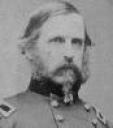 Brigadier General (Dr.) Edward Augustus Wild (1825 – 1891) was the son of homeopath Dr. Charles Wild (1795 – 1864).
Brigadier General (Dr.) Edward Augustus Wild (1825 – 1891) was the son of homeopath Dr. Charles Wild (1795 – 1864).
Edward Wild studied at Harvard College and at Jefferson Medical College and joined the Massachusetts Medical Society and the Massachusetts Society of Homeopathy, where he became a member of several committees.
His colleague and fellow member of the American Institute of Homeopathy, Israel Tisdale Talbot, described Wild as ‘… one of the most remarkable men who had ever been a member of the Institute…’
Wild gave an address to the American Institute of Homeopathy in 1860 on ‘mind over matter’.
Wild practiced alongside his father and Benjamin Eddy Cotting (president of the Massachusetts Medical Society 1874-6), as a homeopath physician and he then travelled to Europe, increasing his medical knowledge by attending lectures in Paris, and by taking a foolhardy walking tour through Italy in the midst of the war and revolution of the Risorgimento.
Giuseppe Garibaldi freed Edward Augustus Wild after he was captured and suspected of being a spy in Italy in 1849. When Wild got back to America, the Civil War was brewing.
Wild served as a captain in the 1st Massachusetts Infantry from May 1861 until July 1862. He fought in First Battle of Bull Run and again in the Peninsula Campaign, where he was wounded at the Battle of Seven Pines.
On August 21, he was appointed Colonel of the 35th Massachusetts Infantry and assigned to the Army of the Potomac‘s IX Corps. Wild led his new regiment into combat during the Maryland Campaign. At the Battle of South Mountain, Wild suffered another severe wound, one that necessitated the amputation of his left arm. He returned home to recuperate.
By April 1863, Wild had recovered enough to resume his military duties, and was promoted to brigadier general on April 24 and assigned to recruiting duties. A fervent abolitionist, he aggressively recruited black soldiers for the United States Colored Troops, as well as helping recruit white officers to lead them, including helping Robert Gould Shaw fill his officer complement for the 54th Massachusetts Infantry.
Wild was friends with fellow abolitionist and author Harriet Beecher Stowe and enlisted her half-brother, James C. Beecher, as a white officer in one of the new black regiments.
When Wild was able to resume his field duties, he freed hundreds of slaves in North Carolina and resettled them safely on Roanoke Island in Virginia, and then recruited many of them to join the military.
Wild took command of a brigade of black infantry that soon became known as “Wild’s African Brigade.” The brigade, headquartered in Norfolk, was comprised of the 55th Massachusetts Infantry, and the 2nd and 3rd North Carolina Colored Volunteers (which later became renumbered as the 36th and 37th U.S. Colored Troops respectively).
Wild’s men served in the Charleston, South Carolina, area and saw action in numerous skirmishes and battles in that region, including an expedition to South Mills and Camden Court House in December.
Transferred to the Army of the Potomac in 1864, Wild and his black soldiers participated in the Overland Campaign and the subsequent Siege of Petersburg, Wild’s men constructed and manned Fort Pocahontas, an earthen-walled Virginia fort on the James River that withstood an attack on May 24 by Fitzhugh Lee‘s Confederates.
In early 1865, Wild’s men performed picket duty along the Appomattox River. They were a part of the large force of black troops under Godfrey Weitzel that occupied the former Confederate national capital, Richmond, Virginia, holding that city through the end of the war.
Wild’s men were among those troops who witnessed the historic visit of President Lincoln to Richmond following the city’s fall to the Union forces.
After the war, Wild could no longer practice medicine due to his war injuries. He engaged in silver mining in Nevada as a superintendent of operations. He operated in the Diana Mine, now part of the Berlin-Ichthyosaur State Park near Austin. He subsequently traveled extensively in South America.
He died in Medellín, Colombia, and was buried in the city’s Cementerio de San Pedro.
After his death, the American Institute of Homeopathy held a memorial service and his classmates from Harvard put up a plaque in his honour on the west end of Memorial Hall.


Leave A Comment